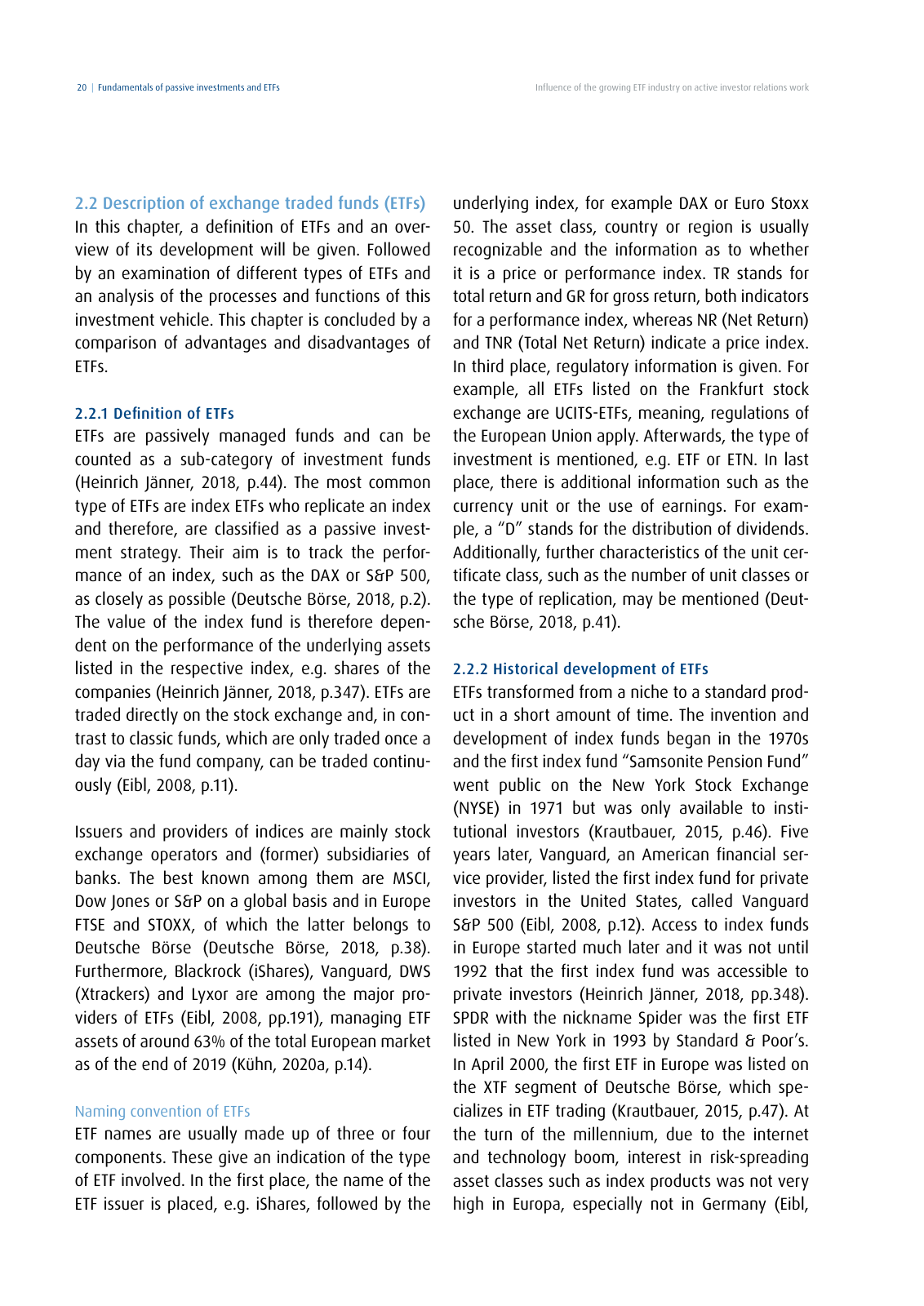Influence of the growing ETF industry on active investor relations work20 Fundamentals of passive investments and ETFs 2 2 Description of exchange traded funds ETFs In this chapter a definition of ETFs and an over view of its development will be given Followed by an examination of different types of ETFs and an analysis of the processes and functions of this investment vehicle This chapter is concluded by a comparison of advantages and disadvantages of ETFs 2 2 1 Definition of ETFs ETFs are passively managed funds and can be counted as a sub category of investment funds Heinrich Jänner 2018 p 44 The most common type of ETFs are index ETFs who replicate an index and therefore are classified as a passive invest ment strategy Their aim is to track the perfor mance of an index such as the DAX or S P 500 as closely as possible Deutsche Börse 2018 p 2 The value of the index fund is therefore depen dent on the performance of the underlying assets listed in the respective index e g shares of the companies Heinrich Jänner 2018 p 347 ETFs are traded directly on the stock exchange and in con trast to classic funds which are only traded once a day via the fund company can be traded continu ously Eibl 2008 p 11 Issuers and providers of indices are mainly stock exchange operators and former subsidiaries of banks The best known among them are MSCI Dow Jones or S P on a global basis and in Europe FTSE and STOXX of which the latter belongs to Deutsche Börse Deutsche Börse 2018 p 38 Furthermore Blackrock iShares Vanguard DWS Xtrackers and Lyxor are among the major pro viders of ETFs Eibl 2008 pp 191 managing ETF assets of around 63 of the total European market as of the end of 2019 Kühn 2020a p 14 Naming convention of ETFs ETF names are usually made up of three or four components These give an indication of the type of ETF involved In the first place the name of the ETF issuer is placed e g iShares followed by the underlying index for example DAX or Euro Stoxx 50 The asset class country or region is usually recognizable and the information as to whether it is a price or performance index TR stands for total return and GR for gross return both indicators for a performance index whereas NR Net Return and TNR Total Net Return indicate a price index In third place regulatory information is given For example all ETFs listed on the Frankfurt stock exchange are UCITS ETFs meaning regulations of the European Union apply Afterwards the type of investment is mentioned e g ETF or ETN In last place there is additional information such as the currency unit or the use of earnings For exam ple a D stands for the distribution of dividends Additionally further characteristics of the unit cer tificate class such as the number of unit classes or the type of replication may be mentioned Deut sche Börse 2018 p 41 2 2 2 Historical development of ETFs ETFs transformed from a niche to a standard prod uct in a short amount of time The invention and development of index funds began in the 1970s and the first index fund Samsonite Pension Fund went public on the New York Stock Exchange NYSE in 1971 but was only available to insti tutional investors Krautbauer 2015 p 46 Five years later Vanguard an American financial ser vice provider listed the first index fund for private investors in the United States called Vanguard S P 500 Eibl 2008 p 12 Access to index funds in Europe started much later and it was not until 1992 that the first index fund was accessible to private investors Heinrich Jänner 2018 pp 348 SPDR with the nickname Spider was the first ETF listed in New York in 1993 by Standard Poor s In April 2000 the first ETF in Europe was listed on the XTF segment of Deutsche Börse which spe cializes in ETF trading Krautbauer 2015 p 47 At the turn of the millennium due to the internet and technology boom interest in risk spreading asset classes such as index products was not very high in Europa especially not in Germany Eibl

Hinweis: Dies ist eine maschinenlesbare No-Flash Ansicht.
Klicken Sie hier um zur Online-Version zu gelangen.
Klicken Sie hier um zur Online-Version zu gelangen.